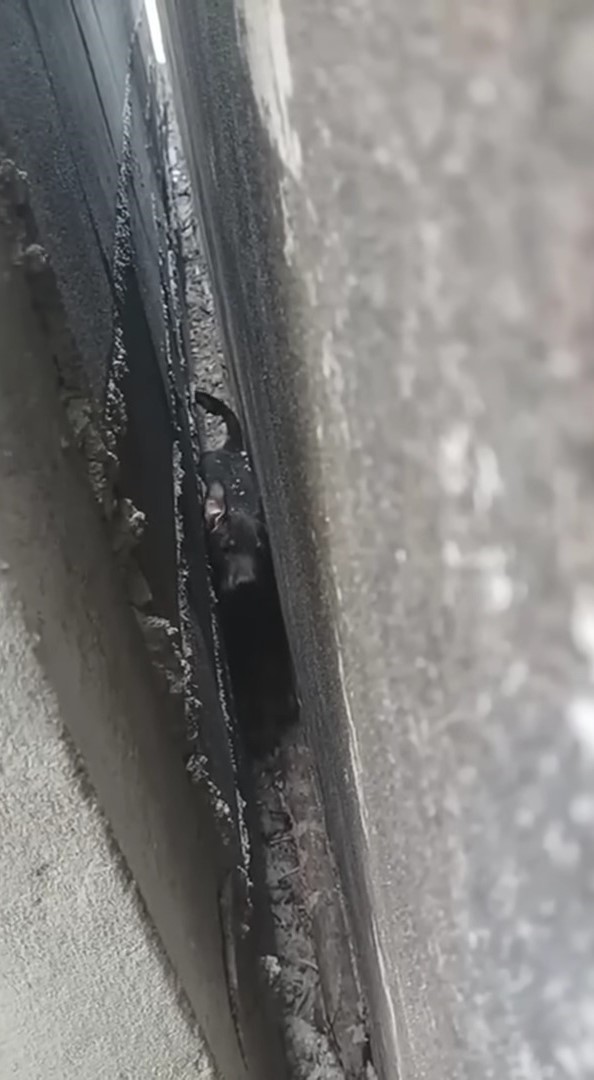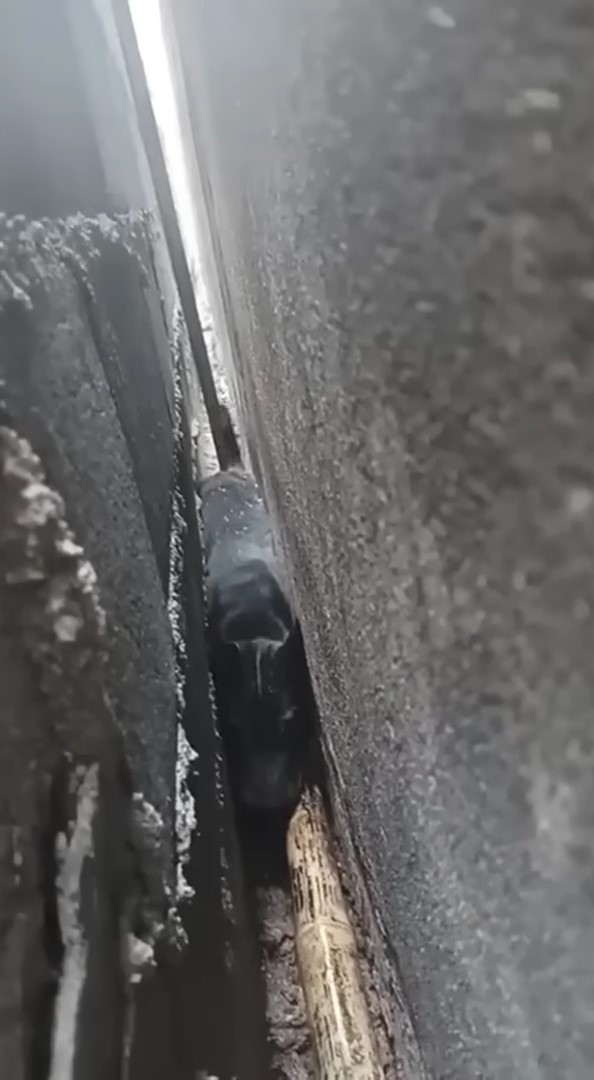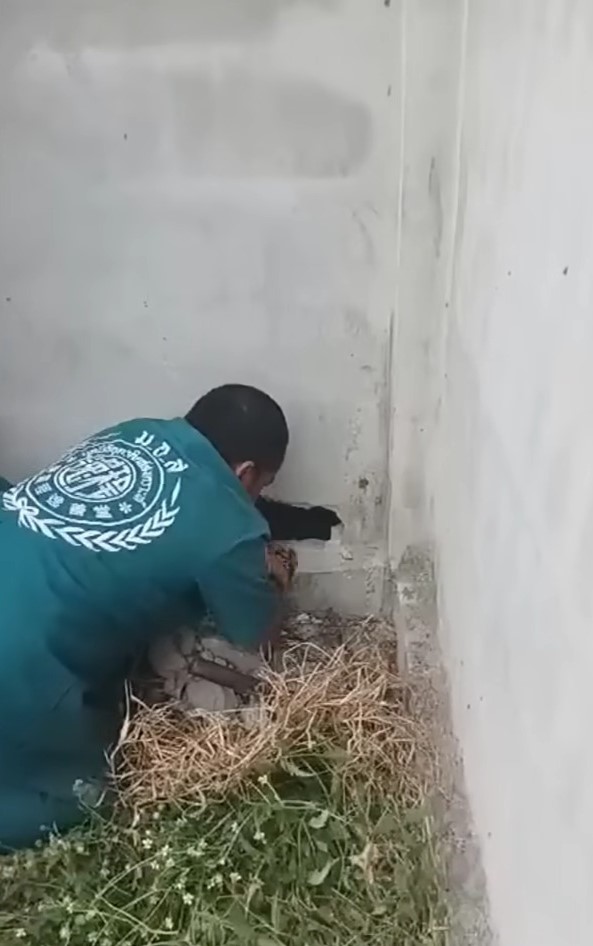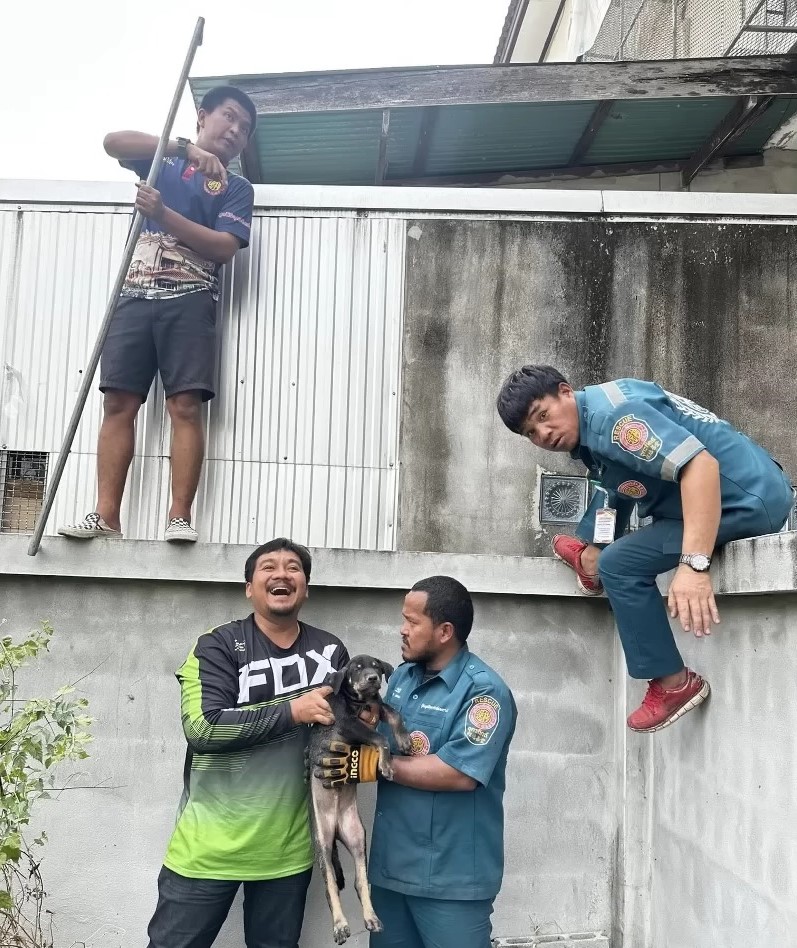I must admit, I have always been a very resilient person and could deal with seeing a lot of bad things without being too affected.
However, one thing that always leaves me completely heartbroken is seeing a dog desperately crying when in trouble.
Being a dog lover myself, they have always been my weakness, and I just have a hard time seeing them suffer, so I always try to help out any way I can.
In this story, we will talk about a dog who was trapped in between two walls of a house before somebody noticed him and came to help.
He Was So Scared

When a group of rescuers received information about this dog who got himself stuck, they rushed to help immediately and were on the scene in no time.
They were shocked to see just how small the gap was, and they didn’t have any idea how to approach this problem. It was going to be really hard.
The poor pup couldn’t stop crying, as he was so afraid that he was going to get hurt. They used a pipe that they hoped he could reach and latch on to, but to no avail.
All of them were so distressed seeing him so scared, but that only made them even more determined to help him get out of this trouble.

When they realized that it was going to be quite a difficult task, they decided to try something new to save him.
In the meantime, one of the rescuers reached inside as much as he could and gave the poor pup some water.
20 minutes later and the situation was still dire. They tried using one of the pipes to push him forward and it kind of worked. He managed to move at least 0.5 meters.
They could reach him now, but there was one problem. The rescuers were unsure if the dog was going to get hurt if they tried to pull him out, so they remained patient.
A Sigh Of Relief

After thinking for a bit, they thought that a good idea would be to try and cut through one of the walls that was holding him.
So, they did just that and noticed that they could probably get him out easier this way. The rescuers kept making holes in the wall, so it was easier for the puppy to get out.
He was finally able to peek out with his head from the wall, and they tried getting just a little bit of the wall out of the way.
They then pulled him out slowly. He was so traumatized but grateful that they rescued him.

The kind rescuers realized that he was only about five months old and he didn’t have anyone caring for him.
It was only thanks to the kindness of everyone involved that he was now safe and sound. These people are the real heroes.
After a very difficult rescue, the captain of the rescue team decided that he would care for the sweet puppy, so he took him home.
It’s because of wonderful people like him that dogs all around the world get another chance at life, and we should all strive to be like that.
Ever wondered why dogs have a peculiar habit of sniffing each other’s behinds? It’s a behavior that might seem odd to us, but in the world of canines, it’s a form of communication unlike any other. When your furry friend greets another dog with a quick sniff, it’s not just a casual hello; there’s a whole world of information being exchanged through their sense of smell.
As a seasoned dog trainer, you’ve probably observed this behavior countless times during your training sessions. But have you ever stopped to think about the fascinating reasons behind why dogs engage in this unique form of interaction? In this article, we’ll delve into the intriguing world of why dogs sniff butts and uncover the hidden meanings behind this seemingly strange behavior.
The Canine Communication Method
Dogs rely heavily on their sense of smell to communicate with each other. When your furry friend sniffs another dog’s rear end, it’s not just a random behavior. This sniffing ritual is how dogs gather a wealth of information about the other dog.
Here’s why dogs sniff butts:
- Scent Identity: Each dog has a unique scent, like a fingerprint. By sniffing another dog’s rear, they can identify the individual and categorize them based on their scent.
- Social Hierarchy: Dogs establish their social rank through scent. The scents exchanged during butt sniffing help dogs understand each other’s status and hierarchy in the pack.
- Emotional State: Dogs can pick up on emotional cues through scent. Sniffing butts allows them to gauge the emotional state of the other dog, whether they’re anxious, fearful, or friendly.
- Reproductive Status: Female dogs in heat release specific pheromones that male dogs can detect. Butt sniffing helps dogs determine the reproductive status of others.
- Health Check: Dogs can detect illness or parasites through scent. By sniffing butts, they can assess the health and wellness of other dogs in their environment.
So, the next time you witness your furry pal engaging in this behavior, remember that it’s their way of engaging in a sophisticated form of communication that goes far beyond just a simple greeting.
The Olfactory System of Dogs
When it comes to understanding why dogs sniff butts, it all boils down to their remarkable olfactory system. Dogs possess an incredibly keen sense of smell that’s far superior to humans. It’s like having an entire world of scents at their nose-tips.
- Superior Smelling Skills:
Dogs’ noses are designed to pick up even the faintest of scents. From identifying individuals to getting a read on emotions, their sniffing prowess is unmatched. - Unique Scent Profiles:
Each dog has its own signature smell, like a personal aromatic fingerprint. By sniffing each other’s behinds, they can gather a wealth of information about one another. - Social Status and Communication:
Butt sniffing isn’t just about saying hello—it’s a way for dogs to establish hierarchy, understand social cues, and communicate without a bark or a growl. - Health Checks and Reproductive Status:
Believe it or not, dogs can even detect health conditions and reproductive readiness through sniffing. It’s like a nose-led health check!
In a nutshell, the next time you see a dog engaging in this seemingly bizarre behavior, remember—it’s their way of tapping into a rich olfactory world that’s simply beyond our human comprehension.
Evolutionary Perspective on Butt Sniffing
Dogs’ interest in sniffing each other’s behinds traces back to their evolutionary roots.
- Enhanced Communication: Butt sniffing allows dogs to communicate essential information swiftly. This behavior helps them gather crucial details about other dogs’ identity, hierarchy, emotions, reproductive state, and overall health.
- Inherited Instincts: Through evolution, dogs have developed a keen sense of smell, far superior to humans’. This heightened olfactory ability enables them to discern intricate details from scents, making butt sniffing an efficient method of communication.
- Social Significance: In the wild, understanding another animal’s scent provided crucial survival information. By sniffing butts, dogs establish social bonds, convey messages, and ensure harmonious interactions with their pack members.
- Health Evaluation: Butt sniffing isn’t merely a social gesture; it also helps dogs assess the health and well-being of their counterparts. Changes in scent can indicate illness or distress, prompting appropriate responses from the sniffing dog.
- Evolutionary Advantage: This olfactory communication strategy has stood the test of time, offering dogs a distinct advantage in understanding their environment and forming intricate social connections, contributing to their survival and thriving as a species.
Social Etiquette and Canine Behavior
Dogs use sniffing as a way to understand and communicate with each other. When your furry friend greets another dog with a butt sniff, it’s their way of learning important info such as the dog’s identity, status, and emotions. It’s like dogs exchanging ID cards in a unique language only they understand.
Imagine going to a party where you can’t ask someone their name directly. Instead, you’d have to rely on subtle hints like their clothes, hairstyle, and perfume. For dogs, scent carries a wealth of details. A quick sniff can reveal if the other dog is a friend or foe, happy or fearful, and even if they’re ready to mate or feeling unwell.
This behavior traces back to their ancestors who relied on scent for survival. For wild dogs, understanding scent meant knowing who belonged to the pack, who was in charge, and who to trust. By continuing this practice, your pet taps into their primal instincts, enhancing their social skills and ensuring effective communication with their furry pals.
So next time you see your dog engaging in this peculiar yet fascinating behavior, remember that it’s their way of being polite and getting to know their fellow canines on a deeper level.
The Human Perception and Interpretation
When it comes to why dogs sniff butts, your interpretation as a human can be quite different from how dogs perceive it. While you might find this behavior odd or even inappropriate, dogs have a whole different take on it.
- Scent Identification: To dogs, sniffing butts is like a social handshake. They gather crucial information such as identity, emotions, and health through scent. It’s their way of getting to know each other and sharing important details without saying a word.
- Social Hierarchy: Dogs establish their hierarchy through scent. When they sniff each other’s behinds, they are essentially determining who’s in charge. It might seem strange to us, but it’s a natural way for them to maintain order in their social structure.
- Understanding Emotions: Dogs are masters at reading emotions through scent. By sniffing another dog’s rear end, they can pick up on cues about their mood and emotional state. This helps them interact better with their furry companions.
- Reproductive Status: Sniffing butts also allows dogs to gather information about each other’s reproductive status. This is vital for mating purposes and ensures that dogs only engage in breeding behavior when the time is right.
- Health Indicators: Believe it or not, dogs can detect certain health conditions through scent. By sniffing another dog’s behind, they can assess their overall health and well-being. It’s like a mini health check-up in the canine world.
While you might cringe at the idea of dogs sniffing butts, for them, it’s an essential aspect of communication and social interaction. Understanding why dogs engage in this behavior can help you appreciate their unique way of connecting with each other on a deeper level.
Conclusion
So, next time you catch your furry friend engaging in some butt-sniffing action, remember that it’s not just a quirky habit – it’s their way of saying “hello” and gathering important information. Dogs have a fascinating way of communicating through scent, thanks to their incredible sense of smell and evolutionary history. By understanding the significance behind this behavior, you can appreciate the intricate social dynamics at play in the canine world. Embrace your dog’s unique way of connecting with others and recognize the depth of their communication beyond just barks and tail wags. Dogs truly have a remarkable way of building relationships and establishing bonds through their distinctive form of non-verbal interaction.
Frequently Asked Questions
What is the significance of dogs sniffing each other’s behinds?
Dogs sniff each other’s behinds to gather information about identity, hierarchy, emotions, reproductive status, and health, serving as a form of social etiquette and communication among dogs.
How does dogs’ sense of smell contribute to effective communication through scent?
Dogs’ superior sense of smell, evolved over time, enables them to communicate effectively through scent, aiding in survival, social bonding, and exchanging essential information.
Why is butt-sniffing considered a form of social handshake among dogs?
Butt-sniffing among dogs is perceived as a social handshake as it helps them identify each other, establish social hierarchy, understand emotions, determine reproductive status, and assess health conditions.
[no_toc]

Hey there, I’m Janet Brooks, a dog-loving student from California. I’m all about helping pups in need, especially those without homes. Me and my awesome friends work together to give shelter and love to stray dogs. Oh, and I also write blogs about dogs to share helpful info.